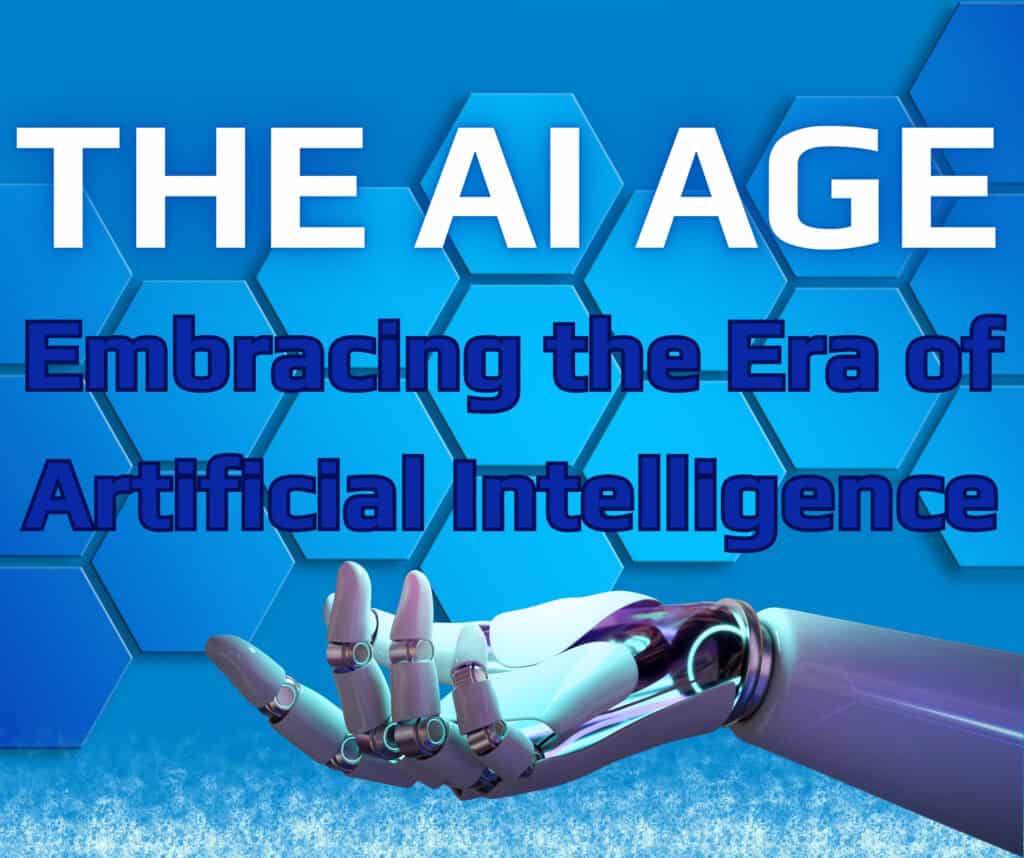The “AI Age” refers to the current era where artificial intelligence (AI) has become a central force in technological advancement and societal transformation. This period is characterized by the widespread adoption and integration of AI technologies into various aspects of life, from business operations to personal conveniences. The AI Age marks a significant shift from traditional computing to sophisticated, intelligent systems capable of learning, adapting, and performing tasks that previously required human intervention.
Dreaming of financial freedom? Start your online business today by clinking below.
Try Wealthy Affiliate (For Free).
Brief History of Artificial Intelligence
Artificial intelligence, as a field of study, has its roots in the mid-20th century. Here’s a brief timeline highlighting key milestones in AI’s evolution:
- 1950s: The concept of AI was first proposed by Alan Turing, who introduced the idea of machines simulating human intelligence and formulated the Turing Test to evaluate a machine’s ability to exhibit intelligent behavior. The term “artificial intelligence” was coined in 1956 during the Dartmouth Conference, where pioneers like John McCarthy and Marvin Minsky laid the foundation for the field.
- 1960s-1970s: Early AI research focused on symbolic AI and problem-solving techniques. This era saw the development of early AI programs like ELIZA, a natural language processing program, and expert systems designed to mimic human decision-making in specific domains.
- 1980s-1990s: The rise of machine learning and neural networks marked a significant shift. Researchers began to explore statistical methods and algorithms that could learn from data. The backpropagation algorithm for training neural networks was introduced, leading to advancements in pattern recognition and data analysis.
- 2000s: The advent of big data and increased computing power spurred rapid progress in AI. Innovations such as support vector machines, ensemble methods, and deep learning algorithms started to gain traction, leading to breakthroughs in image and speech recognition.
- 2010s-Present: The AI Age truly began to take shape with the rise of deep learning and neural networks, powered by vast amounts of data and advanced hardware. Notable achievements include AlphaGo’s victory over a world champion Go player, the widespread adoption of AI in consumer technology, and the development of sophisticated language models like GPT-3. AI technologies now permeate various sectors, including healthcare, finance, transportation, and entertainment.
Importance and Relevance of AI Today
Artificial intelligence has become an integral part of modern life, influencing numerous aspects of daily activities and business operations. Its importance and relevance are evident in several key areas:
- Economic Growth: AI drives innovation and efficiency, leading to the creation of new markets and job opportunities. Companies leveraging AI technologies often experience significant competitive advantages, driving economic growth and transformation.
- Enhanced Decision-Making: AI systems provide valuable insights through data analysis and predictive modeling, enabling businesses and individuals to make more informed decisions. This capability extends to various fields, including finance, healthcare, and marketing.
- Improved Efficiency and Automation: AI automates repetitive tasks, reducing the need for human intervention and allowing for more efficient operations. This automation enhances productivity, lowers costs, and improves accuracy across numerous industries.
- Personalization and Convenience: AI technologies power personalized recommendations and services, enhancing user experiences in areas such as e-commerce, content consumption, and customer support. Virtual assistants and smart home devices exemplify how AI contributes to convenience and improved quality of life.
- Addressing Complex Challenges: AI plays a crucial role in solving complex global issues, such as climate change, disease diagnosis, and resource management. Its ability to analyze vast amounts of data and identify patterns offers potential solutions to some of the world’s most pressing problems.
Key Developments in Artificial Intelligence
Advances in Machine Learning and Deep Learning
Machine Learning (ML) is a subset of artificial intelligence that focuses on developing algorithms and statistical models that enable computers to improve their performance on tasks through experience. Over the years, machine learning has seen remarkable advances:
- Algorithmic Improvements: Machine learning algorithms have evolved from basic techniques, such as linear regression and decision trees, to more sophisticated models, including ensemble methods like random forests and gradient boosting. These advancements enhance the accuracy and robustness of predictive models.
Want to make money online? Start your journey today.
Try Wealthy Affiliate (For Free).
- Scalability and Performance: With the rise of big data, machine learning algorithms have been designed to handle and analyze vast datasets more efficiently. Techniques such as parallel processing and distributed computing have improved the scalability and performance of ML systems.
- Deep Learning: Deep learning, a specialized subset of machine learning, involves neural networks with many layers (hence “deep”). These networks can automatically learn hierarchical representations of data. Breakthroughs in deep learning include:
- Convolutional Neural Networks (CNNs): CNNs have revolutionized image recognition tasks, enabling high-accuracy object detection and classification in images and videos.
- Recurrent Neural Networks (RNNs): RNNs, and their advanced variants like Long Short-Term Memory (LSTM) networks, are designed to handle sequential data and are widely used in applications such as time-series prediction and natural language processing.
- Transformers: The transformer architecture has significantly advanced natural language understanding and generation, leading to state-of-the-art models like GPT-3 and BERT.
Evolution of Natural Language Processing (NLP)
Natural Language Processing (NLP) is a field of AI that focuses on the interaction between computers and human languages. NLP has evolved significantly, driven by advancements in both algorithmic techniques and computational resources:
- Early Approaches: Initial NLP systems relied on rule-based methods and symbolic approaches to understand and generate human language. These systems used predefined rules and linguistic structures to process text and speech.
- Statistical Methods: The introduction of statistical methods in NLP marked a shift from rule-based systems to data-driven approaches. Techniques such as n-gram models and Hidden Markov Models (HMMs) enabled the analysis of language patterns based on probabilities derived from large corpora.
- Neural Networks and Deep Learning: The integration of neural networks into NLP has led to significant advancements. Key developments include:
- Word Embeddings: Techniques like Word2Vec and GloVe represent words as dense vectors in a continuous space, capturing semantic relationships between words.
- Contextual Models: The development of models like BERT (Bidirectional Encoder Representations from Transformers) and GPT (Generative Pre-trained Transformer) has enabled contextual understanding of language, allowing models to grasp nuances and generate coherent text.
- Conversational AI: Advances in NLP have led to the creation of sophisticated conversational agents and chatbots capable of understanding and generating human-like responses in real-time.
Breakthroughs in Computer Vision and Robotics
Computer Vision is an AI field focused on enabling machines to interpret and understand visual information from the world. Key breakthroughs in computer vision include:
- Object Detection and Recognition: Advanced algorithms like YOLO (You Only Look Once) and Faster R-CNN have improved the ability to detect and classify objects within images and videos in real-time.
- Image Generation: Generative Adversarial Networks (GANs) have made it possible to create realistic images and videos by training two neural networks—a generator and a discriminator—to compete with each other.
- Facial Recognition: Machine learning techniques have greatly enhanced facial recognition capabilities, enabling applications in security, personalized experiences, and even emotion detection.
Robotics involves the design and development of robots capable of performing tasks autonomously or semi-autonomously. Key developments in robotics include:
- Autonomous Navigation: Advances in computer vision and machine learning have enabled robots to navigate complex environments and perform tasks with minimal human intervention. Technologies such as LiDAR (Light Detection and Ranging) and SLAM (Simultaneous Localization and Mapping) are crucial for autonomous navigation.
- Collaborative Robots (Cobots): Cobots are designed to work alongside humans in shared spaces. They are equipped with advanced sensors and AI algorithms to safely and efficiently interact with human workers.
- Robot Learning: Machine learning techniques, such as reinforcement learning, allow robots to learn from their interactions with the environment, improving their performance and adaptability over time.
Impact of AI on Various Industries
Healthcare
AI in Diagnostics and Treatment Artificial intelligence is revolutionizing the healthcare industry by enhancing diagnostic accuracy and improving treatment protocols. Key advancements include:
- Medical Imaging Analysis: AI algorithms, particularly those based on deep learning, can analyze medical images (such as X-rays, MRIs, and CT scans) with high precision. These systems can identify patterns and anomalies that might be missed by human eyes, aiding in the early detection of conditions like cancer and neurological disorders.
- Predictive Analytics: AI models can analyze vast amounts of patient data to predict disease outbreaks, identify high-risk patients, and suggest preventative measures. For example, predictive analytics can forecast the likelihood of a patient developing certain conditions based on their medical history and genetic information.
Personalized Medicine and Patient Care AI is also advancing personalized medicine, tailoring treatments and care to individual patients:
- Tailored Treatment Plans: AI systems can analyze genetic data, lifestyle factors, and treatment outcomes to recommend personalized treatment plans. This approach increases the effectiveness of interventions and minimizes adverse effects.
- Virtual Health Assistants: AI-powered virtual assistants and chatbots provide 24/7 support to patients, offering health advice, medication reminders, and follow-up care. These tools enhance patient engagement and adherence to treatment regimens.
Finance
AI in Trading and Investment Strategies In the financial sector, AI is transforming trading and investment strategies through:
- Algorithmic Trading: AI algorithms analyze market data and execute trades at high speeds and with remarkable accuracy. These systems use historical data, real-time information, and complex mathematical models to make trading decisions and optimize investment portfolios.
- Market Prediction: AI models can predict market trends by analyzing vast datasets, including social media sentiment, news articles, and economic indicators. This predictive capability helps investors make informed decisions and identify profitable opportunities.
Risk Assessment and Fraud Detection AI enhances risk management and fraud detection in finance by:
- Risk Modeling: AI systems assess credit risk and market risk by analyzing historical data and identifying patterns that indicate potential financial instability. This enables financial institutions to manage risk more effectively and make better lending decisions.
- Fraud Detection: AI algorithms detect fraudulent activities by analyzing transaction patterns and identifying anomalies. These systems can flag suspicious transactions in real-time, reducing the risk of financial fraud and enhancing security.
Retail
AI-Driven Customer Experiences AI is reshaping the retail industry by creating personalized and engaging customer experiences:
- Recommendation Engines: AI-driven recommendation systems analyze customer behavior and preferences to suggest products tailored to individual tastes. This personalization increases customer satisfaction and drives sales.
- Chatbots and Virtual Assistants: Retailers use AI-powered chatbots to handle customer inquiries, provide product information, and assist with order processing. These tools enhance the shopping experience by offering quick and accurate support.
Ready for a change? Start your online business with a click.
Try Wealthy Affiliate (For Free).
Inventory Management and Supply Chain Optimization AI improves inventory management and supply chain efficiency through:
- Demand Forecasting: AI models analyze historical sales data, market trends, and external factors to predict future demand. This helps retailers optimize inventory levels, reduce stockouts, and minimize excess inventory.
- Supply Chain Optimization: AI enhances supply chain management by optimizing logistics, route planning, and supplier selection. Advanced algorithms can predict delays, manage shipments, and ensure timely delivery of goods.
Transportation
Autonomous Vehicles and Smart Infrastructure AI is driving innovation in transportation with autonomous vehicles and smart infrastructure:
- Autonomous Vehicles: AI technologies enable vehicles to operate independently by using sensors, cameras, and machine learning algorithms to navigate roads, recognize objects, and make driving decisions. Self-driving cars aim to improve road safety, reduce traffic congestion, and provide more efficient transportation options.
- Smart Infrastructure: AI-powered smart infrastructure, such as traffic management systems and smart traffic lights, enhances urban mobility by optimizing traffic flow, reducing congestion, and improving safety. These systems use real-time data to adjust traffic signals and manage transportation networks effectively.
Traffic Management and Logistics AI improves traffic management and logistics by:
- Traffic Prediction and Optimization: AI algorithms analyze traffic patterns and predict congestion, allowing cities to implement measures to alleviate traffic jams and improve travel times. This includes dynamic traffic signal control and adaptive traffic management systems.
- Logistics and Fleet Management: AI optimizes fleet management by analyzing data on vehicle performance, routes, and fuel consumption. This optimization reduces operational costs, improves delivery times, and enhances overall logistics efficiency.
Benefits of Embracing AI
Increased Efficiency
Automation of Routine Tasks One of the most significant benefits of AI is its ability to automate routine and repetitive tasks. This automation offers several advantages:
- Cost Reduction: By automating tasks that would otherwise require human labor, organizations can reduce operational costs. This includes tasks such as data entry, customer service inquiries, and simple decision-making processes.
- Error Reduction: AI systems are less prone to errors compared to humans when performing repetitive tasks. This leads to improved accuracy and consistency in operations, reducing the likelihood of mistakes that can affect quality and efficiency.
- Faster Execution: AI-driven automation accelerates task completion. For example, automated systems can process large volumes of transactions or analyze data much faster than human workers, leading to quicker turnaround times and more efficient operations.
Affiliate Disclosure: Some of the links in this post are affiliate links, meaning I may earn a commission if you make a purchase. However, these links offer valuable resources for your online journey.
Try Wealthy Affiliate (For Free).
Enhanced Productivity and Operational Efficiency AI enhances productivity and operational efficiency through:
- Optimized Workflows: AI can streamline workflows by identifying bottlenecks and inefficiencies. For example, AI systems can optimize supply chain operations, manage inventory more effectively, and automate scheduling tasks.
- Real-Time Insights: AI provides real-time data analysis and insights, enabling organizations to make informed decisions quickly. This leads to improved responsiveness and adaptability in dynamic business environments.
- Resource Management: AI systems help manage resources more effectively by predicting demand, optimizing asset utilization, and minimizing waste. This ensures that resources are allocated efficiently and utilized to their full potential.
Innovation and New Opportunities
Creation of New Job Roles and Industries While AI may automate certain tasks, it also creates new job roles and industries, contributing to economic growth:
- Emerging Job Roles: The rise of AI has led to the creation of new job roles such as AI specialists, data scientists, machine learning engineers, and AI ethicists. These roles focus on developing, implementing, and managing AI technologies.
- New Industries: AI has spurred the growth of new industries, including those focused on AI research, autonomous vehicles, and AI-driven healthcare solutions. These industries offer new opportunities for investment and career development.
- Skill Development: The demand for AI-related skills has led to the growth of educational programs and training initiatives. This fosters a skilled workforce capable of driving innovation and adapting to technological advancements.
Enhanced Problem-Solving and Decision-Making Capabilities AI improves problem-solving and decision-making through:
- Advanced Analytics: AI systems analyze complex datasets to uncover patterns and insights that may not be apparent through traditional methods. This advanced analytics capability helps organizations address intricate problems and make data-driven decisions.
- Predictive Modeling: AI uses predictive modeling to forecast future trends and outcomes. This capability is valuable for strategic planning, risk management, and identifying opportunities for growth.
- Decision Support Systems: AI-powered decision support systems assist in evaluating multiple scenarios and recommending optimal solutions. This enhances the quality of decisions made in various fields, from business strategy to healthcare treatment plans.
Improved Quality of Life
AI in Home Automation and Personal Assistance AI enhances quality of life through home automation and personal assistance:
- Smart Home Devices: AI-powered smart home devices, such as thermostats, lighting systems, and security cameras, automate household tasks and provide greater convenience. For example, smart thermostats can adjust temperatures based on user preferences and behaviors, leading to energy savings and increased comfort.
- Virtual Assistants: AI-driven virtual assistants, such as Amazon’s Alexa or Google Assistant, help with daily tasks like setting reminders, managing schedules, and controlling smart home devices. These assistants offer a personalized and hands-free experience, simplifying everyday activities.
- Health Monitoring: Wearable devices equipped with AI can monitor vital signs, track physical activity, and provide health insights. This technology enables proactive health management and enhances overall well-being.
Advancements in Education and Accessibility AI contributes to education and accessibility by:
- Personalized Learning: AI-driven educational platforms offer personalized learning experiences by adapting content and pacing to individual student needs. This personalization helps students learn more effectively and at their own pace.
- Adaptive Tools: AI-powered tools assist students with learning disabilities by providing adaptive learning solutions and support. For instance, speech-to-text applications and language translation tools enhance accessibility and facilitate inclusive education.
- Remote Learning: AI supports remote learning environments by providing virtual classrooms, interactive content, and real-time feedback. This enables students to access high-quality education regardless of geographical location.
Challenges and Considerations
Ethical Concerns
Bias in AI Algorithms Bias in AI algorithms is a significant ethical concern, as it can lead to unfair and discriminatory outcomes. Key aspects include:
- Data Bias: AI systems learn from historical data, which may contain biases reflecting societal inequalities or prejudices. For example, if an AI system is trained on data with gender or racial biases, it may perpetuate or even exacerbate these biases in its decisions and predictions.
- Algorithmic Bias: Even if the training data is unbiased, the design of the AI algorithms themselves can introduce biases. This might occur due to biased assumptions in the model or unintended consequences of the algorithm’s design.
- Impact on Individuals: Bias in AI can affect individuals in critical areas such as hiring, lending, and law enforcement. For instance, biased AI algorithms might lead to discriminatory hiring practices or unfair treatment in the criminal justice system.
Unlock your potential and start earning online. Click now.
Try Wealthy Affiliate (For Free).
Privacy and Data Security Issues AI systems often require access to large amounts of personal data, raising concerns about privacy and data security:
- Data Collection and Usage: AI systems collect and analyze personal information, which can lead to privacy concerns if the data is not handled properly. Unauthorized access or misuse of data can compromise individuals’ privacy.
- Data Security: Protecting the data used by AI systems from breaches and cyberattacks is crucial. Inadequate security measures can expose sensitive information, leading to potential misuse and harm.
- Transparency and Consent: Ensuring transparency in how data is collected and used, and obtaining informed consent from individuals, is essential for addressing privacy concerns and maintaining trust.
Economic Impact
Job Displacement and Economic Inequality The adoption of AI can lead to job displacement and contribute to economic inequality:
- Job Displacement: AI and automation can replace certain jobs, particularly those involving repetitive tasks or routine activities. This displacement can affect workers in various industries, leading to unemployment or the need for re-skilling.
- Economic Inequality: The benefits of AI adoption may be unevenly distributed, with large corporations and tech-savvy individuals gaining more advantages compared to smaller businesses and less skilled workers. This can widen the gap between different socio-economic groups.
- Workforce Transition: To mitigate these impacts, there is a need for policies and programs that support workforce transition, including retraining and upskilling initiatives to help workers adapt to new job roles created by AI.
Costs of AI Adoption and Implementation Implementing AI solutions involves significant costs, which can be a barrier for some organizations:
- Initial Investment: The development, deployment, and maintenance of AI systems require substantial financial investment. This includes costs for technology, infrastructure, and skilled personnel.
- Ongoing Maintenance: AI systems need continuous monitoring, updating, and refining to ensure they function correctly and remain effective. These ongoing costs can be a burden, especially for smaller businesses.
- Return on Investment: Organizations must carefully evaluate the potential return on investment (ROI) of AI initiatives. Ensuring that the benefits of AI outweigh the costs is crucial for successful adoption and long-term sustainability.
Regulation and Governance
Need for AI Regulations and Standards The rapid development of AI necessitates the establishment of regulations and standards to ensure responsible and ethical use:
- Regulatory Frameworks: Governments and regulatory bodies need to develop frameworks that address AI-related risks and ensure compliance with ethical standards. These frameworks should cover areas such as data protection, algorithmic transparency, and accountability.
- Global Cooperation: Given the global nature of AI technology, international cooperation is essential for creating consistent regulations and standards. This can help address challenges that cross national borders and ensure that AI development aligns with global ethical norms.
- Accountability: Clear guidelines and regulations are needed to establish accountability for AI systems’ actions and decisions. This includes defining who is responsible for addressing issues arising from AI operations, such as errors or biases.
Balancing Innovation with Ethical Practices Balancing innovation with ethical practices is crucial for the responsible development and deployment of AI:
- Ethical Design: AI systems should be designed with ethical considerations in mind, including fairness, transparency, and respect for privacy. Ethical design principles help ensure that AI technologies are developed and used in ways that benefit society while minimizing harm.
- Stakeholder Involvement: Engaging various stakeholders, including ethicists, technologists, policymakers, and the public, in the development and oversight of AI systems can help address diverse perspectives and ensure that ethical concerns are considered.
- Continuous Evaluation: Regular evaluation of AI systems and their impact on society is necessary to adapt to new challenges and ensure that ethical practices are upheld. This includes monitoring the effects of AI on individuals and communities and making adjustments as needed.
The Future of the AI Age
Predictions for AI Advancements and Trends
Advancements in AI Technology The future of AI promises continued advancements in technology, which are likely to shape various aspects of our lives:
- General Artificial Intelligence (AGI): While current AI systems are specialized and narrow, there is ongoing research into developing AGI—machines with the ability to understand, learn, and apply knowledge across a wide range of tasks at a level comparable to human intelligence. The realization of AGI could revolutionize multiple industries by offering unprecedented problem-solving capabilities.
Turn your passion into profit. Click below to get started.
Try Wealthy Affiliate (For Free).
- Improved Machine Learning Models: AI models will continue to evolve, becoming more efficient and accurate. Techniques such as deep learning, reinforcement learning, and transfer learning will advance, leading to better performance in tasks like natural language understanding, image recognition, and autonomous decision-making.
- Quantum Computing: The integration of quantum computing with AI has the potential to dramatically enhance computational power, enabling the solving of complex problems that are currently infeasible with classical computers. This could lead to breakthroughs in drug discovery, materials science, and cryptography.
Emerging Trends in AI Several trends are expected to shape the future of AI:
- AI Ethics and Governance: As AI technologies become more pervasive, there will be increased focus on developing ethical guidelines and governance frameworks to ensure responsible AI use. This includes addressing issues related to fairness, transparency, and accountability.
- AI in Everyday Life: AI will become increasingly integrated into daily life through smart home devices, personalized digital assistants, and advanced healthcare solutions. These applications will enhance convenience, safety, and personalized experiences for individuals.
- AI and Sustainability: AI will play a crucial role in addressing environmental challenges by optimizing resource usage, improving energy efficiency, and advancing sustainable practices. AI-driven solutions will contribute to tackling issues such as climate change and resource depletion.
Potential Long-Term Impacts on Society and Economy
Social Impacts The long-term impacts of AI on society will be profound and multifaceted:
- Workforce Transformation: AI will continue to transform the workforce by automating certain jobs and creating new roles. While some jobs may be displaced, there will be a growing demand for skills related to AI development, management, and oversight. Education and training programs will need to evolve to prepare individuals for these changes.
- Social Interaction: AI technologies, such as social robots and virtual companions, will influence how people interact and form relationships. These advancements may enhance social connectivity for some, but also raise questions about the nature of human relationships and the potential for social isolation.
- Ethical and Privacy Concerns: As AI becomes more integrated into personal and public life, concerns about privacy, surveillance, and data security will intensify. Addressing these concerns will require robust privacy protections and transparent data practices.
Economic Impacts AI’s economic impacts will be significant and wide-ranging:
- Economic Growth: AI has the potential to drive economic growth by increasing productivity, fostering innovation, and creating new business opportunities. Industries that leverage AI effectively will likely experience substantial growth and competitive advantage.
- Economic Inequality: The benefits of AI may not be evenly distributed, potentially exacerbating economic inequality. Efforts will be needed to ensure that AI-driven economic gains are accessible to a broad range of individuals and communities, including support for workers affected by automation.
- Shifts in Industry Dynamics: AI will reshape industry dynamics by disrupting traditional business models and creating new market leaders. Companies that effectively integrate AI into their operations will gain a competitive edge, while others may face challenges adapting to the evolving landscape.
Strategies for Adapting to and Thriving in the AI Age
Embracing Continuous Learning and Adaptation To thrive in the AI Age, individuals and organizations must embrace continuous learning and adaptation:
- Skill Development: Investing in ongoing education and skill development is crucial for staying relevant in a rapidly changing job market. This includes acquiring skills in AI-related fields, such as data science, machine learning, and AI ethics.
- Adaptability: Being adaptable to technological changes and new ways of working will be essential. Individuals and organizations should cultivate a mindset of flexibility and openness to innovation.
Leveraging AI for Competitive Advantage Organizations can leverage AI to gain a competitive advantage by:
- Strategic Integration: Identifying opportunities to integrate AI into business processes can enhance efficiency, improve decision-making, and drive innovation. This includes using AI for data analysis, customer insights, and automation.
- Innovation and Experimentation: Embracing a culture of innovation and experimentation allows organizations to explore new AI applications and solutions. Investing in research and development can lead to breakthrough advancements and new business opportunities.
Ready to escape the rat race? Launch your online business here.
Try Wealthy Affiliate (For Free).
Ethical and Responsible AI Practices Ensuring ethical and responsible use of AI is crucial for long-term success:
- Ethical Frameworks: Developing and implementing ethical frameworks for AI use helps address concerns related to bias, privacy, and accountability. This includes establishing guidelines for transparency, fairness, and data protection.
- Stakeholder Engagement: Engaging with stakeholders, including employees, customers, and regulators, can help address concerns and build trust in AI systems. Open communication and collaboration are key to responsible AI deployment.
Conclusion
Recap of the Significance of the AI Age
The AI Age represents a pivotal era in technological advancement, fundamentally transforming various aspects of our lives and society. Its significance can be summarized as follows:
- Technological Revolution: AI is at the forefront of a technological revolution, driving innovations across multiple fields including healthcare, finance, retail, and transportation. Its capabilities extend from automating routine tasks to enhancing complex decision-making processes, reshaping industries and creating new possibilities.
- Economic Impact: The integration of AI into business and economic systems has the potential to boost productivity, foster innovation, and drive economic growth. However, it also presents challenges such as job displacement and economic inequality, necessitating thoughtful strategies for adaptation and inclusivity.
- Social Transformation: AI’s influence extends to social interactions and daily life, enhancing convenience through smart technologies while also raising concerns about privacy, ethical use, and the nature of human relationships. Understanding and addressing these impacts is crucial for a balanced and equitable future.
Final Thoughts on Embracing AI for a Better Future
Embracing AI offers immense opportunities for improving our lives and shaping a better future. However, this potential can only be realized if approached with a mindful and proactive attitude:
- Opportunities for Growth: AI provides avenues for significant growth and development, from advancing healthcare solutions to optimizing business operations. By harnessing AI’s capabilities, we can address complex challenges and create innovative solutions that benefit society as a whole.
- Ethical Considerations: It is essential to balance the pursuit of technological advancements with ethical considerations. Ensuring that AI systems are designed and implemented responsibly, with a focus on fairness, transparency, and privacy, will help build trust and maximize positive outcomes.
- Collaboration and Innovation: The future of AI will be shaped by collaborative efforts between technologists, policymakers, businesses, and the public. Fostering a culture of innovation, ethical responsibility, and continuous learning will enable us to navigate the AI Age effectively and equitably.
Call to Action for Staying Informed and Proactive About AI Developments
As we move forward into the AI Age, staying informed and proactive is crucial for individuals and organizations alike:
- Stay Educated: Keep up with the latest developments in AI technology, trends, and ethical considerations. Engage with educational resources, attend relevant seminars, and participate in discussions to stay knowledgeable about AI advancements and their implications.
- Adapt and Prepare: Embrace a mindset of adaptability and preparation. Whether you’re an individual preparing for future career changes or an organization planning for AI integration, being proactive in developing skills, strategies, and ethical practices will position you for success in the AI-driven world.
- Advocate for Responsible AI: Support and advocate for responsible AI practices and policies. Engage in conversations about the ethical use of AI, promote transparency, and contribute to the development of frameworks that ensure AI benefits are distributed fairly and responsibly.
Want to work from anywhere? Start your journey with a click.
Try Wealthy Affiliate (For Free).
In summary, the AI Age presents both exciting opportunities and significant challenges. By understanding its significance, embracing its potential responsibly, and staying informed and proactive, we can navigate this transformative era and work towards a future where AI contributes positively to our lives and society.
We’d love to hear from you! How have you experienced the impact of AI in your life or industry? Do you have any questions or thoughts about the future of AI and its implications?
Share your experiences, questions, or insights in the comments below. Engaging in these conversations helps us all stay informed and proactive about the evolving AI landscape. Let’s continue the discussion and explore how we can collectively navigate the AI Age!







